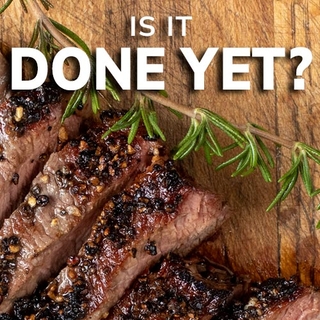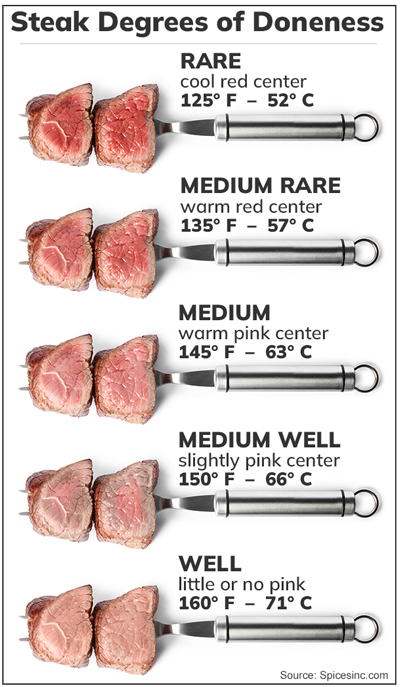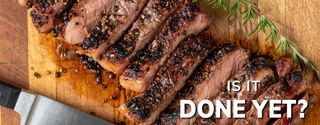Is It Done Yet?

How to Tell if Meat Is Cooked Enough
Tossing steaks on the grill is the iconic image of easy summer dining, but it can be difficult to determine when meat is fully cooked. When is the steak done? How about chicken? And burgers are beef; are they different than steak? There’s a lot to consider when grilling meat, so we’ve put together a guideline to answer these questions.
fully cooked. When is the steak done? How about chicken? And burgers are beef; are they different than steak? There’s a lot to consider when grilling meat, so we’ve put together a guideline to answer these questions.
Every type of meat and seafood has a certain temperature that it should reach before it is eaten. Our guide can help you determine the amount of time you should take to cook some of the most popular grilled meats. Remember that every grill is different, just like an oven, so cook times vary from grill to grill and are all a reasonable approximation. Invest in a good food thermometer, and keep it close at hand to take the temperature of your meat to ensure an accurate finishing temperature for properly cooked food.
Though the terms are often used interchangeably, grilling, barbecuing, and smoking are all different cooking methods. Grilling is a relatively quick way to cook food over high heat, while barbecuing and its cousin, smoking, are adherents to the concept of low-and-slow cooking. You can smoke on a grill, or dress grilled food in barbecue sauce, but remember, grilling is the one with high heat and is the focus of our guideline.
Safe Practices for Cooking Meat
There are a few steps to take to make sure you’re handling meat safely. First and foremost, a clean grill is a healthy grill. Uncooked food is ready to absorb whatever germs you let near it, so scrub down the grates of your grill before cooking. Also make sure you wash your hands before touching any raw meat and make sure that all plates and grilling utensils, including the probe from your meat thermometer, are also clean.
It’s important to take meat out of the refrigerator to let it warm up to room temperature before cooking. Starting the meat at a warmer temperature makes it easier for the cooking elements to heat the meat to safe, edible levels. It also helps prevent uneven cooking, which can lead to food that is not cooked thoroughly enough, or dried out and unpleasant food.
While letting meat reach room temperature, which should take about 20-30 minutes depending on the thickness of the cut of meat, is a necessary step, it’s equally important that meat not remain unrefrigerated for more than two hours. After two unrefrigerated hours, bacteria that is naturally found on meat will multiply and make it unsafe to eat. Any meat that has been sitting out for 2 hours should be thrown away.
How to Tell When Beef is Cooked
Beef, like steaks or roasts, are cooked when they reach the desired internal temperature. Because of its structure, beef has the highest degree of flexibility of the various meats regarding what is considered safe to eat.
All beef should be cooked on a high-heat grill to get the desired sear, which imparts complex flavors. The US Food and Drug Administration recommends steak or roast is cooked to at least 145°F, or medium doneness. They recommend burgers and other foods made with ground beef (and all ground meats) get cooked to at least 160°F, which is well done. Children and the elderly should not eat meat cooked to a lesser degree of doneness than medium.
Use a meat thermometer to accurately determine doneness. The probe from the thermometer should be inserted into the thickest part of the meat, without touching the pan, grill, or any bone. Take steak off the grill when it is approximately 10°F below your target temperature. Set it aside for 5-10 minutes under a foil tent to rest. The residual heat will continue cooking the meat to your target temperature.
Hamburgers do not need time to rest and should be removed from heat when they are at their target temperature.
| BEEF | Cooking Time in Minutes at High Heat | |||||
|---|---|---|---|---|---|---|
| Steak | Heat Type | Thickness | 1/2" | 1" | 1 1/2" | 2" |
|
Rare 125°F |
Direct |
First Side After Flipping |
2 2 |
5 3 |
6 4 |
8 6 |
|
Medium Rare 135°F |
Direct |
First Side After Flipping |
3 2 |
5 4 |
7 5 |
9 8 |
|
Medium 145°F |
Direct |
First Side After Flipping |
4 2 |
6 4 |
7 6 |
10 8 |
|
Medium Well 150°F |
Direct |
First Side After Flipping |
4 4 |
7 5 |
8 7 |
12 10 |
|
Well Done 160°F |
Direct |
First Side After Flipping |
5 3 |
8 6 |
10 8 |
13 11 |
| BEEF | Cooking Time in Minutes at High Heat | |||||
|---|---|---|---|---|---|---|
| Hamburger | Heat Type | Thickness | 1/2" | 1" | ||
|
Well Done 160°F |
Direct, high heat |
First Side After Flipping |
3 3 |
4 5 |
||
How to Tell if Pork is Done
Pork used to have to be cooked until it was fully done to be considered safe to eat, but changes in pork farming and processing have resulted in meat that’s safe to eat at lower degrees of doneness. The FDA recommends pork chops and tenderloin be cooked to at least 145°F, or medium doneness. Ribs should still be cooked thoroughly, to 160°F.
Test doneness with a meat thermometer by inserting the probe into the thickest part of the meat. Don’t let it make contact with the cooking elements, a pan, or a bone. As is done with steak, pork should be removed from heat when it is about 10°F below target temperature and left to rest for 5-10 minutes under a piece of foil.
| PORK | ||||
|---|---|---|---|---|
| Heat Type | Cooking Time in Minutes | |||
|
Pork Chops 6-8 ounces - 145°F |
Direct, high heat |
First Side After Flipping |
4 5 |
|
|
Pork Tenderloin 1-1 ½ pounds - 145°F |
Direct, high heat May move to indirect heat if it cooks too quickly |
Side 1 Side 2 |
6-9 minutes 6-9 minutes |
|
|
Ribs 3 pounds - 160°F |
Indirect, medium heat |
Side 1 Side 2 |
up to 1 hr 15 mins up to 1 hr 15 mins |
|
How to Tell if Salmon is Cooked
A standard salmon filet usually measures between 4-5 inches long, is ¾-1 inch thick, and weighs between 6-8 ounces. Its meaty texture makes it an excellent fish on the grill, since it holds together relatively well in the high heat.
Salmon should spend the majority of its cooking time skin-side down. The skin will help hold the fish together when it’s flipped to finish cooking evenly. The flesh will turn whitish and look opaque, and will separate easily with a fork.
You can test doneness with a meat thermometer. Insert the probe of the thermometer into the thickest part of the meat. Don’t let it make contact with the cooking elements or a pan. Remove salmon from heat when it is about 10°F below target temperature and let it rest for 5-10 minutes under a piece of foil.
| SALMON | ||||
|---|---|---|---|---|
| Heat Type | Cooking Time in Minutes | |||
|
Salmon Filet 6-8 ounces - 145°F |
Direct, high heat |
First Side After Flipping |
6-8 2-4 |
|
How to Tell if Chicken is Done
Regardless of what cut of chicken you’re working with, whether it’s chicken breast or wings, drumsticks or thighs, it should be cooked to at least 165°F to eliminate any food-borne pathogens it may be harboring.
Because chicken is lean it is prone to dry out during cooking, so it’s important to make sure you start it off at room temperature, and that chicken breast is pounded to a relatively even thickness. This helps it cook evenly; if you cook a piece of chicken that is thick on one end and thin on the other, the thinner end will get dry and possibly even burnt as you wait for the thick part to cook through.
Its lean nature also means you should cook it over less intense heat. Since chicken does not have fatty marbling to help keep it moist, a hotter cooking temperature will boil any interior moisture right out of the chicken. Cook it over medium to medium-high heat to prevent drying.
Chicken, like other meats, should be allowed to rest after cooking. Check the temperature with your meat thermometer, being careful not to hit bone or any cooking elements. Remove it from heat when the temperature reads 165°F. Cover it with foil and let it sit for 5 minutes. This will allow the juices in the meat to redistribute, and create a more succulent piece of meat.
| CHICKEN | ||||
|---|---|---|---|---|
| Heat Type | Cooking Time in Minutes at Medium/High Heat | |||
|
Boneless Breast 6-8 ounces - 165°F |
Direct, medium-high heat |
First Side After Flipping |
8-10 6-8 |
|
|
Wings 2-3 ounces each - 165°F |
Direct |
First Side After Flipping |
8 10 |
|

